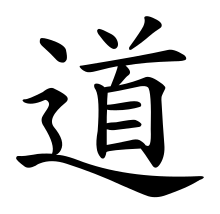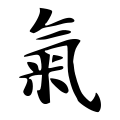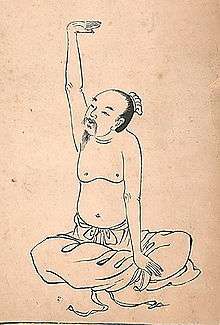Qi
In traditional Chinese culture, qi or ch'i (/ˈtʃiː/ CHEE simplified Chinese: 气; traditional Chinese: 氣; pinyin: qì ![]()
| Qi (Ch'i) | |||||||||||||||||||||||||||||||||||||||||||
|---|---|---|---|---|---|---|---|---|---|---|---|---|---|---|---|---|---|---|---|---|---|---|---|---|---|---|---|---|---|---|---|---|---|---|---|---|---|---|---|---|---|---|---|
 | |||||||||||||||||||||||||||||||||||||||||||
| Chinese name | |||||||||||||||||||||||||||||||||||||||||||
| Traditional Chinese | 氣 | ||||||||||||||||||||||||||||||||||||||||||
| Simplified Chinese | 气 | ||||||||||||||||||||||||||||||||||||||||||
| |||||||||||||||||||||||||||||||||||||||||||
| Burmese name | |||||||||||||||||||||||||||||||||||||||||||
| Burmese | အသက် | ||||||||||||||||||||||||||||||||||||||||||
| IPA | aasaat | ||||||||||||||||||||||||||||||||||||||||||
| Vietnamese name | |||||||||||||||||||||||||||||||||||||||||||
| Vietnamese alphabet | khí | ||||||||||||||||||||||||||||||||||||||||||
| Hán-Nôm | 氣 | ||||||||||||||||||||||||||||||||||||||||||
| Thai name | |||||||||||||||||||||||||||||||||||||||||||
| Thai | ลมปราณ | ||||||||||||||||||||||||||||||||||||||||||
| RTGS | lmprāṇ | ||||||||||||||||||||||||||||||||||||||||||
| Korean name | |||||||||||||||||||||||||||||||||||||||||||
| Hangul | 기 | ||||||||||||||||||||||||||||||||||||||||||
| Hanja | 氣 | ||||||||||||||||||||||||||||||||||||||||||
| |||||||||||||||||||||||||||||||||||||||||||
| Mongolian name | |||||||||||||||||||||||||||||||||||||||||||
| Mongolian Cyrillic | хийг | ||||||||||||||||||||||||||||||||||||||||||
| Mongolian script | ᠬᠡᠢ ᠶᠢ | ||||||||||||||||||||||||||||||||||||||||||
| |||||||||||||||||||||||||||||||||||||||||||
| Japanese name | |||||||||||||||||||||||||||||||||||||||||||
| Kyūjitai | 氣 | ||||||||||||||||||||||||||||||||||||||||||
| Shinjitai | 気 | ||||||||||||||||||||||||||||||||||||||||||
| |||||||||||||||||||||||||||||||||||||||||||
| Malay name | |||||||||||||||||||||||||||||||||||||||||||
| Malay | chi | ||||||||||||||||||||||||||||||||||||||||||
| Indonesian name | |||||||||||||||||||||||||||||||||||||||||||
| Indonesian | chi | ||||||||||||||||||||||||||||||||||||||||||
| Filipino name | |||||||||||||||||||||||||||||||||||||||||||
| Tagalog | qi | ||||||||||||||||||||||||||||||||||||||||||
| Lao name | |||||||||||||||||||||||||||||||||||||||||||
| Lao | ຊີວິດ | ||||||||||||||||||||||||||||||||||||||||||
| Khmer name | |||||||||||||||||||||||||||||||||||||||||||
| Khmer | ឈី | ||||||||||||||||||||||||||||||||||||||||||
| Tetum name | |||||||||||||||||||||||||||||||||||||||||||
| Tetum | qi | ||||||||||||||||||||||||||||||||||||||||||
| Part of a series on |
| Chinese folk religion |
|---|
 |
|
Theory
Model humanity: |
|
Institutions and temples |
|
Internal traditions Major cultural forms
Main philosophical traditions: Ritual traditions: Devotional traditions: Zhenkong, "Void of Truth". Confucian churches and sects:
|
|
Related religions
|
| Part of a series on |
| Taoism |
|---|
 |
|
Practices
|
|
Deities |
|
Organisations |
Believers of qi describe it as a vital force, the flow of which must be unimpeded for health. Qi is a pseudoscientific, unverified concept,[2][3] which has never been directly observed, and is unrelated to the concept of energy used in science[4][5][6] (vital energy itself being an abandoned scientific notion).[7]
Linguistic aspects
The cultural keyword qì is analyzable in terms of Chinese and Sino-Xenic pronunciations. Possible etymologies include the logographs 氣, 气, and 気 with various meanings ranging from "vapor" to "anger", and the English loanword qi or ch'i.
Pronunciation and etymology
The logograph 氣 is read with two Chinese pronunciations, the usual qì 氣 "air; vital energy" and the rare archaic xì 氣 "to present food" (later disambiguated with 餼).
Pronunciations of 氣 in modern varieties of Chinese with standardized IPA equivalents include: Standard Chinese qì /t͡ɕʰi˥˩/, Wu Chinese qi /t͡ɕʰi˧˦/, Southern Min khì /kʰi˨˩/, Eastern Min ké /kʰɛi˨˩˧/, Standard Cantonese hei3 /hei̯˧/, and Hakka Chinese hi /hi˥/.
Pronunciations of 氣 in Sino-Xenic borrowings include: Japanese ki, Korean gi, and Vietnamese khi.
Reconstructions of the Middle Chinese pronunciation of 氣 standardized to IPA transcription include: /kʰe̯iH/ (Bernard Karlgren), /kʰĭəiH/ (Wang Li), /kʰiəiH/ (Li Rong), /kʰɨjH/ (Edwin Pulleyblank), and /kʰɨiH/ (Zhengzhang Shangfang).
Reconstructions of the Old Chinese pronunciation of 氣 standardized to IPA transcription include: /*kʰɯds/ (Zhengzhang Shangfang) and /*C.qʰəp-s/ (William H. Baxter and Laurent Sagart).
The etymology of qì interconnects with Kharia kʰis "anger", Sora kissa "move with great effort", Khmer kʰɛs "strive after; endeavor", and Gyalrongic kʰɐs "anger".[8]
Characters
In the East Asian languages, qì has three logographs:
- 氣 is the traditional Chinese character, Korean hanja, and Japanese kyūjitai ("old character form") kanji
- 気 is the Japanese shinjitai ("new character form") kanji
- 气 is the simplified Chinese character.
In addition, qì 炁 is an uncommon character especially used in writing Daoist talismans. Historically, the word qì was generally written as 气 until the Han dynasty (206 BCE–220 CE), when it was replaced by the 氣 graph clarified with mǐ 米 "rice" indicating "steam (rising from rice as it cooks.)"
This primary logograph 气, the earliest written character for qì, consisted of three wavy horizontal lines seen in Shang dynasty (c. 1600–1046 BCE) oracle bone script, Zhou dynasty (1046–256 BCE) bronzeware script and large seal script, and Qin dynasty (221–206 BCE) small seal script. These oracle, bronze, and seal scripts logographs 气 were used in ancient times as a phonetic loan character to write qǐ 乞 "plead for; beg; ask" which did not have an early character.
The vast majority of Chinese characters are classified as radical-phonetic characters. Such characters combine a semantically suggestive "radical characters" with a phonetic element approximating ancient pronunciation. For example, the widely known word dào 道 "the Dao; the way" graphically combines the "walk" radical 辶 with a shǒu 首 "head" phonetic. Although the modern dào and shǒu pronunciations are dissimilar, the Old Chinese *lˤuʔ-s 道 and *l̥uʔ-s 首 were alike. The regular script character qì 氣 is unusual because qì 气 is both the "air radical" and the phonetic, with mǐ 米 "rice" semantically indicating "steam; vapor".
This qì 气 "air/gas radical" was only used in a few native Chinese characters like yīnyūn 氤氲 "thick mist/smoke", but was also used to create new scientific characters for gaseous chemical elements. Some examples are based on pronunciations in European languages: fú 氟 (with a fú 弗 phonetic) "fluorine" and nǎi 氖 (with a nǎi 乃 phonetic) "neon". Others are based on semantics: qīng 氫 (with a jīng 巠 phonetic, abbreviating qīng 輕 "light-weight") "hydrogen (the lightest element)" and lǜ 氯 (with a lù 彔 phonetic, abbreviating lǜ 綠 "green") "(greenish-yellow) chlorine".
Qì 氣 is the phonetic element in a few characters such as kài 愾 "hate" with the "heart-mind radical" 忄or 心, xì 熂 "set fire to weeds" with the "fire radical" 火, and xì 餼 "to present food" with the "food radical" 食.
The first Chinese dictionary of characters, the Shuowen Jiezi(121 CE) notes that the primary qì 气 is a pictographic character depicting 雲气 "cloudy vapors", and that the full 氣 combines 米 "rice" with the phonetic qi 气, meaning 饋客芻米 "present provisions to guests" (later disambiguated as xì 餼).
 Oracle bone script for qì
Oracle bone script for qì Bronzeware script for qì
Bronzeware script for qì Large seal script for qì
Large seal script for qì Small seal script for qì, simplified Chinese character 气 is based on it.
Small seal script for qì, simplified Chinese character 气 is based on it. Traditional Chinese character 氣 qì, also used in Korean hanja. In Japanese kanji, it was used until 1946 when it was simplified to 気.
Traditional Chinese character 氣 qì, also used in Korean hanja. In Japanese kanji, it was used until 1946 when it was simplified to 気.
Meanings
Qi is a polysemous word. The unabridged Chinese-Chinese character dictionary Hanyu Da Cidian defines it as "present food or provisions" for the xì pronunciation but also lists 23 meanings for the qì pronunciation.[9] The modern ABC Chinese-English Comprehensive Dictionary, which enters xì 餼 "grain; animal feed; make a present of food", and a qì 氣 entry with seven translation equivalents for the noun, two for bound morphemes, and three equivalents for the verb.
n. ① air; gas ② smell ③ spirit; vigor; morale ④ vital/material energy (in Ch[inese] metaphysics) ⑤ tone; atmosphere; attitude ⑥ anger ⑦ breath; respiration b.f. ① weather 天氣 tiānqì ② [linguistics] aspiration 送氣 sòngqì v. ① anger ② get angry ③ bully; insult.[10]
English borrowing
Qi was an early Chinese loanword in English. It was romanized as k'i in Church Romanization in the early-19th century, as ch'i in Wade–Giles in the mid-19th century (sometimes misspelled chi omitting the apostrophe), and as qi in Pinyin in the mid-20th century. The Oxford English Dictionary entry for qi gives the pronunciation as /tʃi/, the etymology from Chinese qì "air; breath", and a definition of "The physical life-force postulated by certain Chinese philosophers; the material principle." It also gives eight usage examples, with the first recorded example of k'í in 1850 (The Chinese Repository),[note 1] of ch'i in 1917 (The Encyclopaedia Sinica),[note 2] and qi in 1971 (Felix Mann's Acupuncture)[note 3]
Concept
References to concepts analogous to qi are found in many Asian belief systems. Philosophical conceptions of qi from the earliest records of Chinese philosophy (5th century BCE) correspond to Western notions of humours, the ancient Hindu yogic concept of prana. An early form of qi comes from the writings of the Chinese philosopher Mencius (4th century BCE).
Within the framework of Chinese thought, no notion may attain such a degree of abstraction from empirical data as to correspond perfectly to one of our modern universal concepts. Nevertheless, the term qi comes as close as possible to constituting a generic designation equivalent to our word "energy". When Chinese thinkers are unwilling or unable to fix the quality of an energetic phenomenon, the character qi (氣) inevitably flows from their brushes.
— Manfred Porkert[11]
The ancient Chinese described qi as "life force". They believed it permeated everything and linked their surroundings together. Qi was also linked to the flow of energy around and through the body, forming a cohesive functioning unit. By understanding the rhythm and flow of qi, they believed they could guide exercises and treatments to provide stability and longevity.
Although the concept has been important within many Chinese philosophies, over the centuries the descriptions of qi have varied and have sometimes been in conflict. Until China came into contact with Western scientific and philosophical ideas, the Chinese had not categorized all things in terms of matter and energy. Qi and li (理: "pattern") were 'fundamental' categories similar to matter and energy.
Fairly early on, some Chinese thinkers began to believe that there were different fractions of qi—the coarsest and heaviest fractions formed solids, lighter fractions formed liquids, and the most ethereal fractions were the "lifebreath" that animated living beings.[12] Yuanqi is a notion of innate or prenatal qi which is distinguished from acquired qi that a person may develop over their lifetime.
Philosophical roots
The earliest texts that speak of qi give some indications of how the concept developed. In the Analects of Confucius qi could mean "breath".[13] Combining it with the Chinese word for blood (making 血氣, xue–qi, blood and breath), the concept could be used to account for motivational characteristics:
The [morally] noble man guards himself against three things. When he is young, his xue–qi has not yet stabilized, so he guards himself against sexual passion. When he reaches his prime, his xue–qi is not easily subdued, so he guards himself against combativeness. When he reaches old age, his xue–qi is already depleted, so he guards himself against acquisitiveness.
— Confucius, Analects, 16:7
The philosopher Mozi used the word qi to refer to noxious vapors that would eventually arise from a corpse were it not buried at a sufficient depth.[14] He reported that early civilized humans learned how to live in houses to protect their qi from the moisture that troubled them when they lived in caves.[14] He also associated maintaining one's qi with providing oneself with adequate nutrition.[14] In regard to another kind of qi, he recorded how some people performed a kind of prognostication by observing qi (clouds) in the sky.[14]
Mencius described a kind of qi that might be characterized as an individual's vital energies. This qi was necessary to activity and it could be controlled by a well-integrated willpower.[15] When properly nurtured, this qi was said to be capable of extending beyond the human body to reach throughout the universe.[15] It could also be augmented by means of careful exercise of one's moral capacities.[15] On the other hand, the qi of an individual could be degraded by adverse external forces that succeed in operating on that individual.[15]
Living things were not the only things believed to have qi. Zhuangzi indicated that wind is the qi of the Earth.[16] Moreover, cosmic yin and yang "are the greatest of qi".[16] He described qi as "issuing forth" and creating profound effects.[16] He also said "Human beings are born [because of] the accumulation of qi. When it accumulates there is life. When it dissipates there is death... There is one qi that connects and pervades everything in the world."[16]
Another passage traces life to intercourse between Heaven and Earth: "The highest Yin is the most restrained. The highest Yang is the most exuberant. The restrained comes forth from Heaven. The exuberant issues forth from Earth. The two intertwine and penetrate forming a harmony, and [as a result] things are born."[16]
The Guanzi essay Neiye (Inward Training) is the oldest received writing on the subject of the cultivation of vapor [qi] and meditation techniques. The essay was probably composed at the Jixia Academy in Qi in the late fourth century B.C.[17]
Xun Zi, another Confucian scholar of the Jixia Academy, followed in later years. At 9:69/127, Xun Zi says, "Fire and water have qi but do not have life. Grasses and trees have life but do not have perceptivity. Fowl and beasts have perceptivity but do not have yi (sense of right and wrong, duty, justice). Men have qi, life, perceptivity, and yi." Chinese people at such an early time had no concept of radiant energy, but they were aware that one can be heated by a campfire from a distance away from the fire. They accounted for this phenomenon by claiming "qi" radiated from fire. At 18:62/122, he also uses "qi" to refer to the vital forces of the body that decline with advanced age.
Among the animals, the gibbon and the crane were considered experts at inhaling the qi. The Confucian scholar Dong Zhongshu (ca. 150 BC) wrote in Luxuriant Dew of the Spring and Autumn Annals:[18] "The gibbon resembles a macaque, but he is larger, and his color is black. His forearms being long, he lives eight hundred years, because he is expert in controlling his breathing." ("猿似猴。大而黑。長前臂。所以壽八百。好引氣也。")
Later, the syncretic text assembled under the direction of Liu An, the Huai Nan Zi, or "Masters of Huainan", has a passage that presages most of what is given greater detail by the Neo-Confucians:
Heaven (seen here as the ultimate source of all being) falls (duo 墮, i.e., descends into proto-immanence) as the formless. Fleeting, fluttering, penetrating, amorphous it is, and so it is called the Supreme Luminary. The dao begins in the Void Brightening. The Void Brightening produces the universe (yu–zhou). The universe produces qi. Qi has bounds. The clear, yang [qi] was ethereal and so formed heaven. The heavy, turbid [qi] was congealed and impeded and so formed earth. The conjunction of the clear, yang [qi] was fluid and easy. The conjunction of the heavy, turbid [qi] was strained and difficult. So heaven was formed first and earth was made fast later. The pervading essence (xi–jing) of heaven and earth becomes yin and yang. The concentrated (zhuan) essences of yin and yang become the four seasons. The dispersed (san) essences of the four seasons become the myriad creatures. The hot qi of yang in accumulating produces fire. The essence (jing) of the fire-qi becomes the sun. The cold qi of yin in accumulating produces water. The essence of the water-qi becomes the moon. The essences produced by coitus (yin) of the sun and moon become the stars and celestial markpoints (chen, planets).
— Huai-nan-zi, 3:1a/19
Role in traditional Chinese medicine
The Huangdi Neijing ("The Yellow Emperor's Classic of Medicine", circa 2nd century BCE) is historically credited with first establishing the pathways, called meridians, through which qi allegedly circulates in the human body.[19][20][21]
In traditional Chinese medicine, symptoms of various illnesses are believed to be either the product of disrupted, blocked, and unbalanced qi movement through meridians or deficiencies and imbalances of qi in the Zang Fu organs.[21] Traditional Chinese medicine often seeks to relieve these imbalances by adjusting the circulation of qi using a variety of techniques including herbology, food therapy, physical training regimens (qigong, t'ai chi ch'uan, and other martial arts training),[22] moxibustion, tui na, or acupuncture.[21]:78
The nomenclature of Qi in the human body is different depending on its sources, roles, and locations.[23] For sources there is a difference between so-called "Primordial Qi" (acquired at birth from one's parents) and Qi acquired throughout one's life.[23] Or again Chinese medicine differentiates between Qi acquired from the air we breathe (so called "Clean Air") and Qi acquired from food and drinks (so-called "Grain Qi"). Looking at roles Qi is divided into "Defensive Qi" and "Nutritive Qi".[23] Defensive Qi's role is to defend the body against invasions while Nutritive Qi's role is to provide sustenance for the body. Lastly, looking at locations, Qi is also named after the Zang-Fu organ or the Meridian in which it resides:[23] "Liver Qi", "Spleen Qi", etc.
A qi field (chu-chong) refers to the cultivation of an energy field by a group, typically for healing or other benevolent purposes. A qi field is believed to be produced by visualization and affirmation. They are an important component of Wisdom Healing'Qigong (Zhineng Qigong), founded by Grandmaster Ming Pang.[24][25][26]
Comparable concepts
Concepts similar to qi can be found in many cultures.
Religious beliefs
Prana in Hinduism and Indian culture, chi in the Igbo religion, pneuma in ancient Greece, mana in Hawaiian culture, lüng in Tibetan Buddhism, manitou in the culture of the indigenous peoples of the Americas.
Some elements of the qi concept can be found in the term 'energy' when used in the context of various esoteric forms of spirituality and alternative medicine.
Scientific view
The existence of Qi has not been proven scientifically.[2] A 1997 consensus statement on acupuncture by the United States National Institutes of Health noted that concepts such as qi "are difficult to reconcile with contemporary biomedical information".[27]
The 2014 Skeptoid podcast episode titled "Your Body's Alleged Energy Fields" related a Reiki practitioner's report of what was happening as she passed her hands over a subject's body:
What we'll be looking for here, within John's auric field, is any areas of intense heat, unusual coldness, a repelling energy, a dense energy, a magnetizing energy, tingling sensations, or actually the body attracting the hands into that area where it needs the reiki energy, and balancing of John's qi.[3]
Evaluating these claims, author and scientific skeptic Brian Dunning reported:
...his aura, his qi, his reiki energy. None of these have any counterpart in the physical world. Although she attempted to describe their properties as heat or magnetism, those properties are already taken by – well, heat and magnetism. There are no properties attributable to the mysterious field she describes, thus it cannot be authoritatively said to exist.[3]
Practices involving qi
Feng shui
The traditional Chinese art of geomancy, the placement and arrangement of space called feng shui, is based on calculating the balance of qi, interactions between the five elements, yin and yang, and other factors. The retention or dissipation of qi is believed to affect the health, wealth, energy level, luck, and many other aspects of the occupants. Attributes of each item in a space affect the flow of qi by slowing it down, redirecting it or accelerating it. This is said to influence the energy level of the occupants. Positive qi flows in curved lines, whereas negative qi travels in straight lines.[28] In order for qi to be nourishing and positive, it must continue to flow not too quickly or too slowly.[28] In addition, qi should not be blocked abruptly, because it would become stagnant and turn destructive.[28]
One use for a luopan is to detect the flow of qi.[29] The quality of qi may rise and fall over time. Feng shui with a compass might be considered a form of divination that assesses the quality of the local environment.
There are three kinds of qi, known as heaven qi (tian qi 天气), Earth qi (di qi 地气), and human qi (ren qi 人气).[28] Heaven qi is composed of natural forces including the sun and rain. Earth qi is affected by heaven qi. For example, too much sun would lead to drought, and a lack of sun would cause plants to die off. Human qi is affected by earth qi, because the environment has effects on human beings. Feng shui is the balancing of heaven, Earth, and human qi.
Qigong
Qìgōng (气功 or 氣功) involves coordinated breathing, movement, and awareness. It is traditionally viewed as a practice to cultivate and balance qi. With roots in traditional Chinese medicine, philosophy and martial arts, qigong is now practiced worldwide for exercise, healing, meditation, and training for martial arts. Typically a qigong practice involves rhythmic breathing, slow and stylized movement, a mindful state, and visualization of guiding qi.[30][31][32]
Martial arts
Qi is a didactic concept in many Chinese, Vietnamese, Korean and Japanese martial arts. Martial qigong is a feature of both internal and external training systems in China[33] and other East Asian cultures.[34] The most notable of the qi-focused "internal" force (jin) martial arts are Baguazhang, Xing Yi Quan, T'ai Chi Ch'uan, Southern Praying Mantis, Snake Kung Fu, Southern Dragon Kung Fu, Aikido, Kendo, Hapkido, Aikijujutsu, Luohan Quan, and Liu He Ba Fa.
Demonstrations of qi or ki are popular in some martial arts and may include the unraisable body, the unbendable arm, and other feats of power. Some of these feats can alternatively be explained using biomechanics and physics.[35]
Acupuncture and moxibustion
Acupuncture is a part of traditional Chinese medicine that involves insertion of needles into superficial structures of the body (skin, subcutaneous tissue, muscles) at acupuncture points to balance the flow of qi. This is often accompanied by moxibustion, a treatment that involves burning mugwort on or near the skin at an acupuncture point.
Taoist sexual practices
See also
Notes
- Quoting Confucius that the Taiji or "Great Extreme is the primordial substance (k'í) which, moving along, divided and made two k'í; that which in itself has motion is the Yang, and that which had rest .‥ is the Yin."
- The essence of the ethical principle Li "is absolutely pure and good, but seeing that it is inseparable from the material element Ch'i.‥ it is from Man's birth to a greater or less extent impeded and tainted."
- "To the ancients the cornerstone of the theory of acupuncture, the concept whereby they explained its effects and action, was Qi, the energy of life."
References
- Yu, Deng; Shuanli, Zhu; Peng, Xu; Hai, Deng (1 January 2003). "Ration of Qi with Modern Essential on Traditional Chinese Medicine Qi: Qi Set, Qi Element". Journal of Mathematical Medicine. 16 (4).
- Lee, M. S.; Pittler, M. H.; Ernst, E. (1 June 2008). "Effects of reiki in clinical practice: a systematic review of randomised clinical trials". International Journal of Clinical Practice. 62 (6): 947–54. doi:10.1111/j.1742-1241.2008.01729.x. ISSN 1742-1241. PMID 18410352.
- Dunning, Brian. "Skeptoid #411: Your Body's Alleged Energy Fields". Skeptoid. Retrieved 3 September 2016.
- Shermer, Michael (July 2005). "Full of Holes: the curious case of acupuncture". Scientific American. 293 (2): 30. Bibcode:2005SciAm.293b..30S. doi:10.1038/scientificamerican0805-30. PMID 16053133.CS1 maint: ref=harv (link)
- Stenger, Victor J. (June 1998). "Reality Check: the energy fields of life". Skeptical Briefs. Committee for Skeptical Inquiry. Archived from the original on 11 December 2007. Retrieved 25 December 2007. "Despite complete scientific rejection, the concept of a special biological fields within living things remains deeply engraved in human thinking. It is now working its way into modern health care systems, as non-scientific alternative therapies become increasingly popular. From acupuncture to homeopathy and therapeutic touch, the claim is made that healing can be brought about by the proper adjustment of a person's or animal's 'bioenergetic fields.'"
- "Traditional Medicine and Pseudoscience in China: A Report of the Second CSICOP Delegation (Part 2)". CSICOP. Archived from the original on 4 October 2009. Retrieved 15 February 2009.
- Williams, Elizabeth Ann (2003). A Cultural History of Medical Vitalism in Enlightenment Montpellier. Ashgate. p. 4. ISBN 978-0-7546-0881-3.
- Schuessler, Axel (2006). ABC Etymological Dictionary of Old Chinese. Honolulu: University of Hawaii Press. p. 423. ISBN 9780824829759. Retrieved 5 January 2017.
- Mair, Victor H. (2003). An Alphabetical Index to the Hanyu Da Cidian. Honolulu, Hawaii: University of Hawai'i Press. p. 2011. ISBN 978-0824828165.
- Defrancis, John; Yuqing, Bai (1999). ABC Chinese-English Dictionary. Honolulu: University of Hawai'i Press. p. 465. ISBN 978-0824821548.
- Porkert, Manfred (1974). The Theoretical Foundations of Chinese Medicine: Systems of Correspondence (2nd ed.). Cambridge: M.I.T. Press. ISBN 978-0262160582.
- Definitions and brief historical notes on such concepts can be found in Wei Zhengtong's "Zhong Guo Zhexue Cidian", Da Lin Publishing Company, Taipei, 1977.
- Legge, James (2010). The Analects of Confucius. Auckland: Floating Press. ISBN 978-1775417958.
- Watson, Burton (2003). Mozi: Basic Writings. New York: Columbia University Press. ISBN 978-0231130011.
- Lau, D. C. (2003). Mencius (Revised ed.). Hong Kong: Chinese University Press. ISBN 978-9622018518.
- Watson, Burton (2013). The Complete Works of Zhuangzi. New York: Columbia University Press. ISBN 978-0231536509.
- Loewe, Michael; Shaughnessy, Edward L. (1999). The Cambridge History of Ancient China: From the Origins of Civilization to 221 BC (1st ed.). Cambridge: Cambridge University Press Press. p. 880. ISBN 9780521470308. Retrieved 11 March 2017.
- Guilk, Robert van (2015). The Gibbon in China: An Essay in Chinese Animal Lore. E.J. Brill. p. 38. ISBN 978-7547507391.
- Yu, Deng; Shuanli, Zhu; Hai, Deng (1 January 2002). "Generalized Quanta Wave with Qi on Traditional Chinese Medecine". Journal of Mathematical Medicine. 15 (4).
- Veith, Ilza; Rose, Ken (2002). Huang ti nei ching su wên = The Yellow Emperor's Classic of Medicine (New ed.). Berkeley: University of California Press. ISBN 978-0520229365.
- Lawson-Wood, Denis; Lawson-Wood, Joyce (1983). Acupuncture Handbook. Health Science Press. pp. 4, 133.
- Wu, Kung-tsao (2006) [1980]. Wu Style Tai Chi Chuan 吳家太極拳 [Wu Family T'ai Chi Ch'uan]. Chien-ch’uan T’ai-chi Ch’uan Association. ISBN 978-0978049904.
- "What is Qi in Chinese medicine?". The Journal of Chinese Medicine on Orient Mama. 23 April 2018. Retrieved 29 April 2018.
- Gu, Mingtong (2011). Wisdom Healing (Zhineng) Qigong: Cultivating Wisdom and Energy for Health, Healing and Happiness. Petaluma, California. pp. 61–80. ISBN 978-0983504306.
- Gu, Mingtong (2009). An Introduction to Wisdom Healing Qigong. Petaluma, California. pp. 30, 46–47.
- Hin, Ooi Kean (2010). Zhineng Qigong: The Science, Theory and Practice. North Charleston, South Carolina: CreateSpace. ISBN 9781453867600.
- "The National Institutes of Health (NIH) Consensus Development Program: Acupuncture". Consensus.nih.gov. Retrieved 5 January 2017.
- Henwood, Belinda. (1998). Feng shui : how to create harmony and balance in your living and working environment = Fêng shui. Vancouver: Raincoast Books. ISBN 1-55192-132-4. OCLC 37985099.
- Field, Stephen L. (12 February 1998). "Qimancy, Chinese Divination by Qi". Professor Field's Fengshui Gate. Archived from the original on 23 February 2017. Retrieved 7 November 2017.
- Cohen, Kenneth S.; Dossey, Larry (1999). The Way of Qigong: The Art and Science of Chinese Energy Healin (1st ed.). New York: Ballantine Books. ISBN 978-0345421098.
- Liang, Master Shou-Yu; Wu, Wen-Ching; Breiter-Wu, Denise (1997). Qigong Empowerment: A Guide to Medical, Taoist, Buddhist, and Wushu Energy Cultivation. East Providence, Rhode Island: Way of the Dragon Publishing. ISBN 978-1889659022.
- Jwing-Ming, Yang (1998). Qigong for Health and Martial Arts: Exercises and Meditation (2nd ed.). Boston, Massachusetts: YMAA Publication Center. ISBN 978-1886969575.
- Wile, Douglas (1996). Lost T'ai-chi Classics from the Late Ch'ing Dynasty. Albany: State University of New York Press. ISBN 9780791426548.
- Bishop, Mark (1989). Okinawan Karate: Teachers, Styles and Secret Techniques. London: A & C Black. ISBN 978-0713656664.
- James, Daniel Arthur (27 June 2003). "Unraisable Body: The Physics of Martial Arts". Sports Medicine Australia. Retrieved 5 January 2017.
Further reading
- Wright, Thomas; Eisenberg, David (1995). Encounters with Qi: Exploring Chinese medicine. New York: Norton hi. ISBN 978-0-393-31213-3. OCLC 32998368.
- Powers, John. (1995). Introduction to Tibetan Buddhism. Ithaca, NY: Snow Lion Publications. p. 591. ISBN 978-1-55939-282-2.
External links
| Wikiquote has quotations related to: Qi |
| Look up qi in Wiktionary, the free dictionary. |

